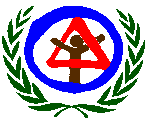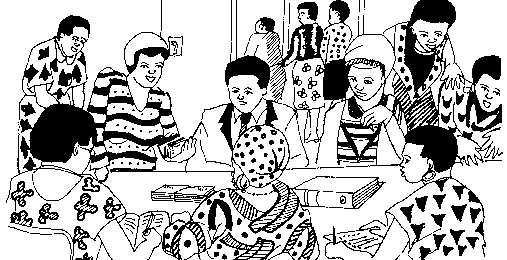
| Top | Purpose | Targets | Ethics | Sectors | Training | Methods | Key Words | Approach | Development | Bottom |
 |
|
| Top | Purpose | Targets | Ethics | Sectors | Training | Methods | Key Words | Approach | Development | Bottom |
| The Purpose of CMP Uganda: |
| The overall purpose of the Community Management Programme (CMP) is: To strengthen community management in the development and operation of human settlements facilities and services. | The programme contributes to improving the living and working conditions of low-income people and is thereby reducing poverty. It aims to: |
|
. . |
|
| Top | Purpose | Targets | Ethics | Sectors | Training | Methods | Key Words | Approach | Development | Bottom |
| The Three Targets: |
While
the overall objective is to empower low income communities, to do so, CMP
aims at three main targets of its activities:
|
. | The
project targets must include more than the communities. Why?
. Communities do not exist or survive in isolation. While they can be assisted in becoming more self reliant (empowered) within themselves, in order to make the process more sustainable, they must also exist within an environment (political, administrative, cultural) of enablement. Assisting, encouraging and training leaders, technical specialists and authorities to shift from a provision approach to an enabling approach supports social change in the direction of that needed environment. That is why there are the three targets, not only the communities, but also those who have influence (by power or by technology) over those communities. |
| Top | Purpose | Targets | Ethics | Sectors | Training | Methods | Key Words | Approach | Development | Bottom |
| Human Rights and Ethical Components: |
|
While CMP falls within the "poverty alleviation" category of development, it does so within the range of ethical and human rights issues of the UN and the UN-sponsored summits and conferences of the last several decades, of which Uganda among others was signatory. |
| Top | Purpose | Targets | Ethics | Sectors | Training | Methods | Key Words | Approach | Development | Bottom |
| Sectors: |
| CMP, like all genuine community development activities, is not focussed upon a single sector in the traditional sense of the word. It cuts across all sectors, and depends upon community participation in the selection of sector for each community based project. | . | While executed by UNCHS (Habitat), the focus of CMP Uganda is not the housing sector, but cross cuts through a whole range of sectors, many related to communal human settlements issues and the development of communities in villages, towns and cities. |
|
| Top | Purpose | Targets | Ethics | Sectors | Training | Methods | Key Words | Approach | Development | Bottom |
| Training: |
Training
in the CMP sense is not the orthodox meaning of only a transfer of skills
to the trainees. Training in CMP involves all the following:
|
| Top | Purpose | Targets | Ethics | Sectors | Training | Methods | Key Words | Approach | Development | Bottom |
| The Uniqueness of CMP Methodology: |
| CMP is breaking new ground. (Uniqueness hidden by much hype about "community participation.") It is unique in that it is engaged in participatory empowerment methods (usually associated with NGOs who bypass Governmental channels) while working through official Governmental channels in order to effect changes in the Governmental modes of operations. | . | True, some of the mainline major international NGOs have gone much further in developing methods of participatory development (including PRA), but the whole NGO community is a mixed bag: may are still involved just in charity and relief (thus causing and increasing dependencies), while others are nothing more than commercial contractors engaged in whatever activities are dictated by the funding agencies. |
| Even those NGOs that are successful in participatory empowerment bypass governmental and official channels (whereas CMP sees these as targets rather than problems to avoid), setting up parallel and competing community decision making systems, and by choosing some communities in which they work, they set up inequities by not choosing the neighbouring communities. | . | Meanwhile many multilateral and governmental agencies pay lip service to participation, but on close inspection are discovered to be engaged in little more than superficial consultation, or asking for community "contribution" (eg communal labour) and calling that "participation." Many agencies that claim to be participatory do so only to impress their funders, and yet demonstrate little understanding of community decision-making processes when they operationalise their activities. |
| Top | Purpose | Targets | Ethics | Sectors | Training | Methods | Key Words | Approach | Development | Bottom |
| Some Key Words: |
| Several words and phrases in the development industry have been misused or used in several (sometimes contradictory) ways. In view of that, we offer CMP-specific meanings for three of them, (habitat, community participation and poverty) ... as follows: |
| Human
Settlements and Habitat:
We in CMP see shelter and human habitat as far more than the technology of dwellings or houses. A house exists because of people and for people. A house alone without communal services, such as access to markets, water and sanitation, enculturation (e.g. education) of the young, communications, transport, markets and other facilities and services, ... is useless. More importantly, a human settlement (rural and urban) is not just a collection of infrastructure, or even of human occupants that are separate consumers; it is a community, a social organization that involves human attributes: beliefs, concepts, economic and political dimensions, social interaction, family and other social reproductive institutions, a set of human languages, traditions, aesthetics and processes. Human settlement development is community development. |
. | Community
Participation:
We see community participation as far more than the contribution of labour or supplies; it is participating in decision making: eg: to chose a community project, to plan it, to implement it, to manage it, and to monitor it. Poverty:
|
| For a more comprehensive set of key words, see the training document, Key Words , in which are not dictionary definitions, but notes to the field worker. |
| Top | Purpose | Targets | Ethics | Sectors | Training | Methods | Key Words | Approach | Development | Bottom |
| Notes on the Uganda CMP Approach to Training: |
| The word "training" is often assumed to be only the transfer of skills to trainees. In CMP Uganda, it goes much further in its role of poverty alleviation and capacity building. |
| Awareness
Raising:
Training is used by CMP as a method to raise public awareness about issues, eg: gender awareness, environmental appropriateness, or the revolutionary motion that poverty is not just an act of God or Destiny but can be changed if people are willing to take the necessary steps. Sensitization is not simple or easy; to raise awareness without raising expectations. Where there is a high level of dependency, community members will expect us to provide resources, not guide them to identify their own resources. |
. | Training
as Mobilization and Organizing:
We do not only train about mobilizing and organizing, we use training as a method of mobilizing and organizing low income groups. This is a methodology that marries techniques from widely varied sources, eg: (a) trade union organizing and (b) high level corporate executive management training. Both are aimed not at individual skill transfer alone but at group formation and organizing for increased capacity and effectiveness. CMP adapted the methods to community strengthening and empowering. See Training to Organize. |
| . | ||
| Training
as Skills Transfer:
Here the CMP meaning is consistent with the orthodox or commonly understood meaning of training (skill transfer), but we do have choices to make about what skills are to be transferred. While some practical skills such as carpentry and masonry are useful, they are not urgently lacking in the communities. What are needed (in strengthening communities) are skills in mobilizing, in planning, in resource identification, in assessment of needs and community priorities, in project design, in proposal writing, in keeping records, in simple project accounting, in monitoring progress, in reporting and report writing, and in financial reporting (accountability). |
. | Training
as Stimulation:
The encouragement of people to act on their own behalf, not to simply hope and wait for outside assistance, is done by letting the target groups know that they have the right (even the duty) and the ability to change things for the better. They are informed of their assets and admirable qualities, not criticized, and they are praised and recognized for their achievements (even the humble one if there is nothing else to praise). This encouragement affects peoples' attitudes, makes them more willing to act on their own behalf and altruistically on behalf of their communities. |
| Top | Purpose | Targets | Ethics | Sectors | Training | Methods | Key Words | Approach | Development | Bottom |
| People Development; Not Hardware Development: |
| Many people, including politicians and news journalists, when they visit community sites of a programme like this, want to see the facilities (eg the latrine, road, clinic, water pump, or school), and judge the success of the programme by the physical constructions. While those may be the objectives of the communities themselves, they are not the objectives of CMP. To CMP, the facilities are only a means of animating social change in the communities. The goal is to increase the strength of the community. | . | The objectives of CMP belong to the "process of social change" aspect of development. CMP encourages and assists community based organizations to build new facilities or rehabilitate and maintain existing ones. The objectives of the community, therefore, are focussed on the physical objects, eg the clinic, the road, the school, the foot bridge, the water supply, the latrine. The objectives of CMP, in contrast, focus on the people, how they are organized, how they relate to external and internal leadership and governance; eg the peoples' attitudes, behaviour, institutional organization. | |
| The objectives of CMP, therefore relate to the "people element" of development, and the physical infrastructure and its construction and maintenance, is seen as a "means" not as an end. The orthodox sectors (water, education, health) for CMP are secondary in importance, so long as the choice of type of activity is chosen by consensus and is identified as a community priority. | . | When
you see a clinic or school built by a community, it is not only the result
of the community management training of CMP, it is (and was) a means
or strategy whereby CMP used community action to increase the capacity
of that community to develop ... itself.
The clinic itself is not the success; the (increased) ability of the community (to choose, plan, and construct it), is the success. |
|
|
|
. |
|
|
|
|
. |
|
|
|
|
. |
|
| Top | Purpose | Targets | Ethics | Sectors | Training | Methods | Key Words | Approach | Development | Bottom |
| A Meeting: |
| _ |  |
_ |
| Top | Purpose | Targets | Ethics | Sectors | Training | Methods | Key Words | Approach | Development | Bottom |
Disclaimer:The documents here express the views of the authors only, and are not necessarily the official executive policy of the UN, SCN, CDS, any NGO or any ministry that implements community development projects.
|
| Top | Purpose | Targets | Ethics | Sectors | Training | Methods | Key Words | Approach | Development | Bottom |